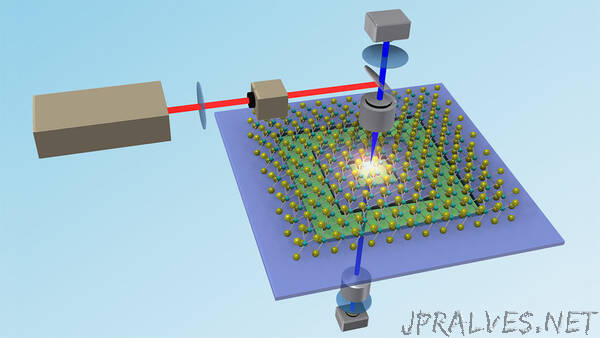
“Polarization, in sync.
On the macro, everyday level, it reads as an oxymoron. To the University of Nebraska–Lincoln’s Xia Hong and her fellow nanoscientists, though, the apparent contradiction makes a kind of harmonious sense. And it might just spur the development of smaller, more versatile optical filters that are especially adept at playing with a trick of the light.
That trick occurs when two packets, or photons, of light strike a material and eject another photon — one with double the energy and half the wavelength — from the material. Because wavelengths differ across the electromagnetic spectrum, the phenomenon can transform incoming infrared waves into waves of blue light, for instance, or that visible light into ultraviolet.
But not just any material can pull off the trick, known as second-harmonic generation. One material that can: an atom-thin layer of molybdenum disulfide. Hong has spent several years exploring the phenomena that emerge from pairing molybdenum disulfide with so-called ferroelectric materials, whose alignment of positive and negative charges will flip when exposed to an electric field.
Last year, she and her colleagues were studying how the optical behavior of single-layer molybdenum disulfide responded when it was placed atop a ferroelectric material called lead zirconate titanate, or PZT.
“We weren’t expecting much,” said Hong, associate professor of physics and astronomy, “but we saw this very, very strange effect.”
Instead of observing second-harmonic generation uniformly across the surface, the team noticed that certain segments were boosting the phenomenon even as others dampened it. The researchers also realized that the unexpected pattern emerged at the PZT’s domain walls, where a section with positive polarization — upward-facing positive charges separated from downward-facing negative charges — met a section with negative polarization. Not only that: The intensity of the reflected second-harmonic generation alternated by wall, so that the first, third and fifth wall boosted it while the second, fourth and sixth were dampening it.
Given that the pattern was missing in either material alone, the researchers figured it must originate from some interaction of the two. On closer inspection, they discovered that vortex-like swirls of the positive and negative charges at the top of the PZT walls — similar to the tornadic rotation that can occur when warm and cool air converge — were contributing to the effect.
When that rotation matched the polarization of the overlying molybdenum disulfide, so that the former swirled clockwise as the latter was aligned left to right, or vice versa, the reflected second-harmonic signal nearly quadrupled in intensity. When those polarizations ran counter to one another, the reflected signal virtually disappeared.
The polarization of the incoming light mattered, too. An electric field surrounding a ray of unpolarized light, such as that coming from the sun, will haphazardly jut out in all directions. The electric field of polarized light, by contrast, will stick to one plane — vertical, horizontal — or rotate around the ray in a predictable, cyclical way. Though incoming light that was polarized at certain angles did produce a clear second-harmonic pattern upon reflecting, the signals disappeared when the team adjusted the light’s polarization to other angles.
As for the wavelengths that passed through the nanostructure, rather than reflecting from it? The team found an intensification-mitigation pattern for those, too. Rather than depending on the match or mismatch of polarization between the materials, though, the second-harmonic generation responded to the polarization of the PZT patches alone. When light was polarized at certain angles, the PZT patches with positive polarization boosted the signal, whereas the negatively polarized patches dampened it. And adjusting the light’s polarization could reverse the relative strengths of those signals.
Hong said the nanostructure’s sensitivity to polarized light, combined with the ability to flip the PZT’s polarization either electrically or mechanically, makes for something unusual: an optical filter that could be programmed and reprogrammed in a matter of seconds.
“It’s nanoscale, and it can be controlled,” Hong said. “So you could say this is a smarter way of filtering, because you can reconfigure it. It’s not a done deal. I can write the polarization like this, I can erase it, (then) I can write it in a different way.
“I think the key is really that it’s a very simple technique.”
The technique’s versatility could prove useful in quickly characterizing materials or substances, Hong said, especially the properties that influence second-harmonic generation or dictate responses to the polarization of light. Though the technique isn’t really suited to the routine, macro-level applications of polarized filtering — “This is clearly not something to make your polarized glasses with,” she said — Hong did muse about a related possibility.
“If you wanted to make a 3D movie at the microscale,” she ventured with a smile, “this is probably the way to do it.”
Hong and her colleagues reported their findings in the journal Nature Communications. She authored the study with Nebraska’s Yongfeng Lu, Evgeny Tsymbal, Dawei Li, Xi Huang, Zhiyong Xiao, Hanying Chen, Le Zhang, Yifei Hao, Jingfeng Song and Ding-Fu Shao.
The team received support from the U.S. Department of Energy’s Office of Science, the National Science Foundation and the Office of Naval Research.”
